Water supply in the wall. Radial distribution of water supply pipes: necessity or excess
Provide comfortable living in an apartment is possible only if you carefully plan all the relevant systems. First of all, this is electricity, gas communications and water supply. It is about the layout of the water pipe in the apartment will be discussed further.
Types of water spreaders
All installation work It is necessary to carry out after drawing up of the plan of distributing and calculation of materials. This will help significantly save time, and reduce the cost of materials. In appearance, there are two options for wiring: open and closed installation.In a closed installation method water pipes For the laying of highways, stitches are used - hollowed trenches in the wall. It is in them that all pipes are installed. This method is considered the most expensive, but in terms of design it is preferable. Outside there are no traces of water pipes and unaesthetic connections. On the other hand, the possible leakage of the system requires complex manipulation, and after its elimination it is necessary to restore the integrity of the walls.
The open method in this plan is much more practical, because there is access to any point of the system without unnecessary efforts. The disadvantages of this method is the non-esthetic appearance of the water supply elements, as well as the reduction of the useful area, which is not always appropriate for small room sizes.
Open or closed method of installing water pipes - this can be solved for yourself, drawing attention to the following facts:
- A hidden water supply does not take up unnecessary space, is aesthetically attractive and is considered a professional accomplishment plumbing works.
- For small bathrooms and toilets, the closed method of installing a water pipe will be the only correct solution ().
- Preventive inspections of the system are easier to do with an open pipe installation method.
- In the event of a fire, there is a chance that the communications will remain intact, which means reducing the cost of recovery.
- For beginners, it's better to use an open method of installation, because you can quickly install and fix the problem.
- For the installation of an open water pipeline, the range of materials used is more extensive.
- Leakage in the system is easier to detect and correct with the open version of the water pipe.
- The open form of the water supply system makes it possible to supplement the system with new consumers.
Useful advice: to hide unsightly pipes and fasteners, you can use false panels of suitable material. This method can be called optimal, because he collected all the advantages of both options.
The appropriate type of "disguise" can be selected according to the general design of the bathroom. Usually for this purpose traditional materials are used for such premises: ceramic tile, moisture resistant plasterboard and plastic panels.
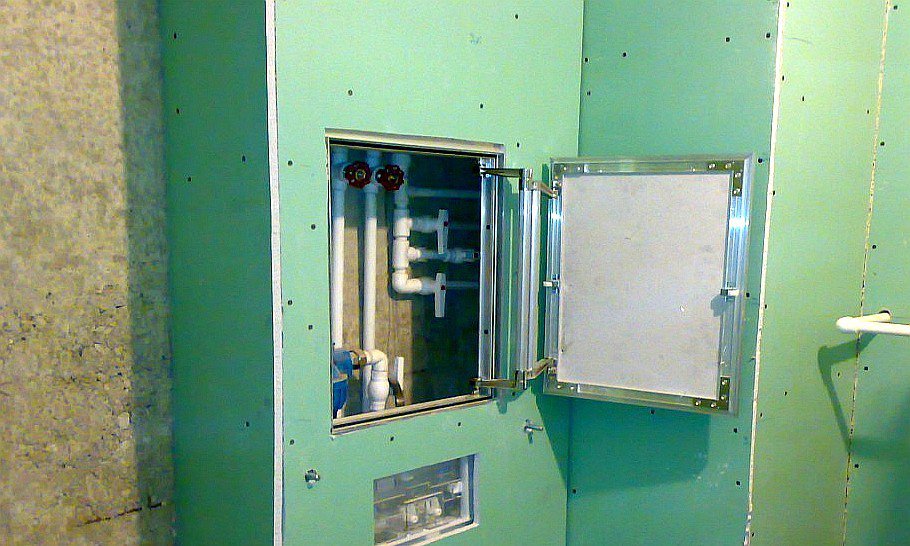
Plumbing diagrams in the apartment
In addition to the pipe installation method (), it is very important to determine in advance the preferred way of connecting all consumers. There will be two outputs: serial and manifold pipes. Both methods have their advantages and disadvantages, so it is advisable to think in advance about all the nuances.The second name for this method is the tee grid, because tees are used to provide power to all consumers. It is thanks to these elements from the main pipe - the riser - all the main lines depart.

The installation of the tee grid requires a minimal amount of materials and does not differ in the complexity of the work. For beginners - this is the best option, because you can make a suitable scheme yourself. At the same time, this kind of connection has a number of drawbacks:
- Many fasteners, which increases the risk of leaks and makes it difficult to detect them.
- Simultaneous inclusion of several points of consumption creates a lack of pressure in the system, so the most remote point will be with a weak pressure.
- Repair work requires a complete shutdown of water, which is not always convenient.
Collector wiring is carried out according to the principle parallel connection. This provides the necessary removal from the main source - the riser. With the help of separately conducted pipes, each distribution source has its own wiring. Of course, with such a connection, the demand for materials is much increased, but this method also has its advantages:
- Constant pressure in the system.
- Elimination of leaks occurs with partial disconnection of water.
- Diagnosis and prevention of leaks is easier than with a serial connection.
- Relatively few fasteners, which provides greater reliability of the system.
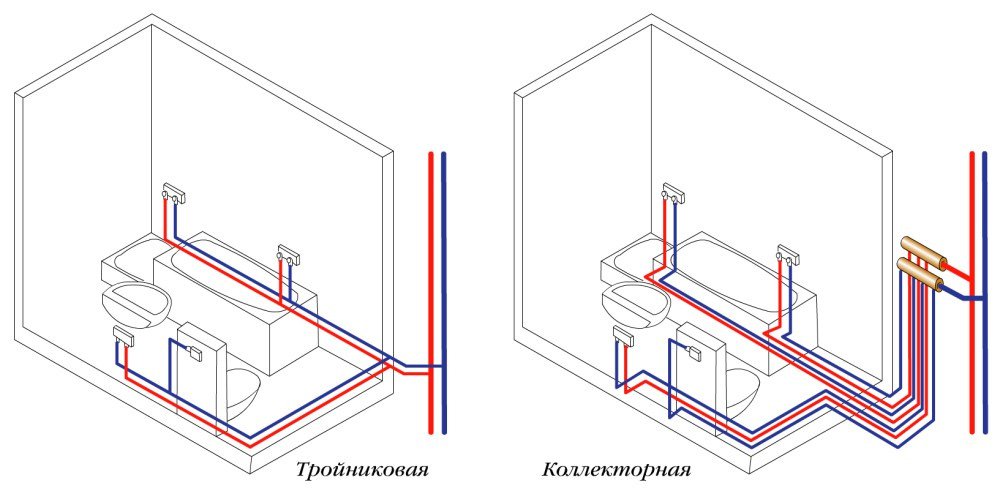
At the same time, the method is not devoid of shortcomings. Coupled with the aforementioned increase in material consumption, this connection requires more skilled work. It will be problematic to perform self-wiring of pipes, and attracting a specialist will increase the repair budget.
Instruction for self-wiring water pipes (video)
To install the pipes of the water supply system, the wave is possible by hand:- Draw a plan for wiring on paper . It should indicate the actual dimensions and all used water consumption points.
- Choose the best option for laying pipes . You can use a combination of open and closed wiring method.
- Complete the basic rules . The wiring must be carried out taking into account such requirements: the pipes do not intersect and are located as close to each other as possible. Thus it is desirable to choose the most simple scheme, without unnecessary connections and fasteners.
- Install inlet valves (ball valves) . They are installed directly to the sources of hot and cold water in the apartment. This will help to shut off water when repair work is needed, connecting and replacing individual elements of the system. Also learn,.
- Output a separate water supply . It is carried out if necessary, and is intended for consumption in food. On this segment, it is necessary to mount filters for deep cleaning.
- Install counters ( ) . They are also mounted in the first place. After them, pressure reducers are installed, which control the pressure of water to the instruments used.
- Installation of other elements of the system .
The video shows the piping of the water supply system and the end result of such works. For example, piping is used in a new building. The selected wiring type - collector circuit. In addition to distributing pipes to consumers, the master describes how to install and mask the water mains. This video instruction is surely useful for beginning masters of plumbing works, and some tips from a professional will help avoid mistakes and time losses when doing the work yourself:
Installation of the plumbing system of the apartment is the responsible part of the arrangement of new housing. Properly designed wiring will ensure comfortable use and reliability of the system. The installation methods and instructions for self-assembly water pipes, described above will help to properly carry out installation work.
From how well the installation of the water supply system of the apartment has been correctly performed, the efficiency of all the equipment connected to it depends. The chosen scheme of water supply of the apartment should ensure timely supply of water from the central water supply to all points of analysis. At the same time, sufficient water pressure should be provided for proper operation of household appliances and other sanitary equipment. At the moment, there are three main schemes for the distribution of the water supply system in a residential building. One of these schemes is called a tee or sequential, the other is a collector one, and the third is a mixed version of the first two. Consider the device data engineering systems.
The system of water supply of the apartment, executed according to this scheme, is the simplest, unpretentious and cheap option engineering communications. It is a consistent scheme of water supply implemented in the homes of the old housing stock, built in Soviet times. However, even now this scheme is used by builders.

In accordance with this scheme, the installation of the main pipelines, through which the hot and cold water supply of the apartment is carried out, is conducted in parallel. At the same time, every plumbing device is connected to pipelines by means of tees. It was from here that the second name of the scheme went - the tee. The sequential scheme provides for the presence of a common for a few water users part of the highway, from which there are numerous branches, connected with tee. Moreover, the main pipe, which plays the role of an elongated collector, has a larger diameter than the diameter of the pipes leaving it and going to each plumbing appliance.
Important! The tee pattern is ideal for the organization of water supply in an ordinary standard apartment, equipped with one bathroom and having a small number of installed plumbing fixtures.
Advantages and disadvantages of a sequential circuit
The advantages of a consistent water supply scheme include:
- saving of pipes;
- reduction in the cost of laying pipes;
- simplicity of the project and ease of its implementation.
However, this system is not devoid of shortcomings, such as:
- decrease in pressure at the end points of connection in the event of a large number of sanitary devices and a drop in the total incoming pressure;
- absence of possibility of selective disconnection of water supply to a separate plumbing device, because it is necessary to block the entire water supply at the common entrance;
- the difficulty of finding leaks, since the branches of the highways are many and they are scattered randomly throughout the system;
- impossibility to provide convenient and quick access to all tee pipe connections, since most of them are hidden under the floor or in the wall;
- violation of the finish in the event of an accident to eliminate the rupture of the water pipe.
Important! If the wiring water supply pipes in an apartment is carried out by competent experts who pay attention to quality of used materials and observe technologies of performance of plumbing works the probability of occurrence of failures and various leaks is reduced to zero. In professionally assembled serial wiring, there are no cases of a differential pressure.
Branch wiring diagram
In connection with the increased use of various plumbing fixtures in the apartment and the need to ensure their normal functioning, the collector scheme for the distribution of the water supply system is increasingly being selected. At the same time, the installation of water supply in the apartment according to this scheme is considered more complicated and expensive. But initially the differential pressure at different points of water consumption is excluded. Therefore, there is no problem with the use of sanitary equipment for the same purpose in the same period of time. What is the reason for this? The fact that a separate pipe is laid at each point of water consumption, which, if desired, can be easily closed and maintained or serviced by a connected plumbing fixture.
Look at the collector scheme of the apartment's water supply system.
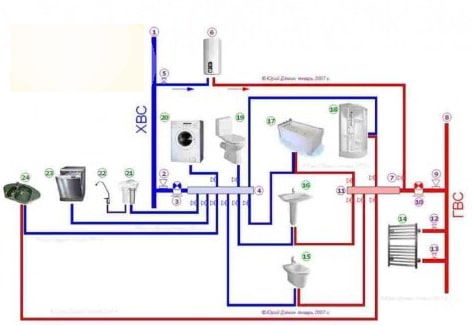
1. Standing cold water supply (HVS).
2. The main valve, overlapping the CV.
3. Filters and pressure reducers.
4. Collector-distributor of HVS.
5. Shut-off valve blocking the supply of cold water to the water heater.
6. Water heater.
7. Shut-off valve, shutting off the supply of hot water from the water heater;
8. Hot water supply stand (DHW).
9. The main DHW valve.
10. Filters and pressure reducers for hot water.
11. Collector-distributor of hot water.
12-13. Shut-off valves that shut off the supply of hot water to the heated towel rail;
14-24. Various sanitary appliances.
The presented diagram clearly shows the basic principle of the collector distribution of water supply pipes , where each water user is connected through a separate pipe directly to the collectors of HVS and DHW. At the same time, the pipe does not have any branching and any unnecessary connections throughout its length, which eliminates the possibility of leakage. The connections are only two and they are available for repair and maintenance (collector-pipe and pipe-water consumer).
Advantages of the collector system of water supply
- Reliability of the system due to the small number of connections.
- Adjustment or complete disconnection of a particular plumbing appliance by using a ball valve mounted on the water supply pipe at the outlet of the collector.
- Ease of maintenance and repair of the system.
- Taking into account the individual characteristics of each plumbing appliance when protecting it - installing filters and gearboxes that provide the required water quality and the level of pressure necessary for optimal functioning.
- Hidden installation of pipes, improving the interior of the apartment as a whole.
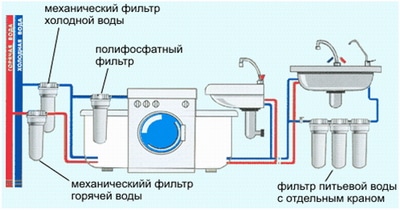
When designing a water supply project for an apartment, it is necessary to determine the layout of the pipes most appropriate to the conditions of operation of the equipment at this facility. Only specialists can competently calculate and plan the device of engineering communications. Of great importance is the installation, which must be carried out in strict accordance with the developed technical documentation and existing in construction technologies. Compliance with rules and regulations in the construction of utilities guarantees the reliability of the water supply system.
Arrangement and replacement of water pipes in the apartment is possible with their own hands, and does not require appropriate permits from the governing bodies. There is a certain sequence, using which, you will not encounter difficulties, changing the sanitary assembly. Therefore, you need to create a certain work plan for yourself.
Initially, each host should think about the material consumption and its dimensions, including the diameter of each individual clutch or pipe. As a rule, residential water supply originates from the central public water supply, so there are conditions for the selection of inventory. So, we begin the development of the plan, which we include:
Attention! Plumbing in the apartment is very inconvenient because of the small size of the room, therefore, from all existing water supply options, one should give preference to the most compact one.
Step-by-step installation of pipes on the water in the apartment with their own hands
With a view to maximally convenient to install a water pipe and leave the site is not too noticeable you can only preliminarily thought out the tactics of execution. and select the desired pipe diameter. In this section we will talk about how the water supply is carried out in all details.
First you need to dismantle the old pipes yourself, if they are installed. When you purchased a living space without equipped communications, the matter becomes somewhat more complicated in the sense that you need to think over a new scheme. It is ideal to build a collector water supply in the apartments.
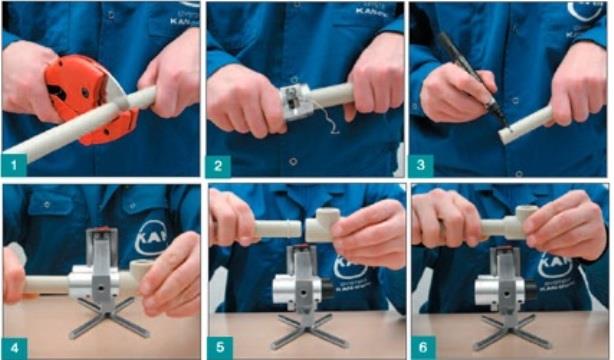
To get rid of the Soviet metal pipes, we first of all shut off the water supply taps on the main risers to stop the supply directly to the apartment. Next, we remove all visible fittings, plumbing and equipment. It is important that the room is left empty and there was a place to turn around. If the meters for hot and cold water are installed separately, they are also removed. In the future, it is possible to reschedule the water supply in such a way that hot water comes from the heating unit. Thus, the immediate repair of the water pipe, which we carry out in steps, has approached.
- Sometimes you can leave an old layout, or better - a new one water supply system . Only water distribution in the apartment can be carried out. This installation is simplified and will suit everyone who has faced plumbing for the first time. We proceed to assemble the pipes on the floor. They should have the correct diameter and be already cut to the required length. We perform all connections accurately and take into account the sealing, then we perform the control of the work done and perform the installation with our own hands of the received construction. If possible, we put cranes on pipes, one must be present before the counter.
Plumbing for a note! If you make the layout of the scheme on the walls and the floor, depending on how the water pipe is laid in the apartment, this will greatly simplify the task and help to avoid mistakes.

Important! In the conditions of apartment arrangement it is possible to apply collectors for water supply, since this variant is compact and ideally suited for the existing situation with water. And for hot water supply it is recommended to use strictly suitable reinforcement.
Features of the application of an open type of plumbing for apartments
At first glance, the decision to install an open water pipe in apartment bathrooms is not appropriate, since according to the majority, a critical lack of space will not allow the installation of existing household appliances, besides, the water mains can not always be present. Therefore, your attention offers advantages and disadvantages this method, which clearly help determine the choice.

Speaking about worthy qualities, for an open water supply method, the choice of absolutely any pipes will suit your own hands. For such constructions there are no special restrictions, it is possible to take into account only the correct diameter, which should correspond to the norms of water pressure. For example, if you select pipes that are too thin, you may encounter a problem with poor water supply, especially when the central pipeline is used as much as possible. On such designs, cranes are installed only in the places of water intake.
Self-assembly is easy and practical, does not have dirty work and does not damage the surface finish of walls and floors, because it can be safely practiced. The diameter of such pipes is 20-25 mm, which will allow them to be conveniently located.
Among the shortcomings of such water supply, there is an uninteresting aesthetic appearance in the room (visibility of all pipes), a decrease in useful area and a slight flammability of the structure in case of fire, which will require additional waste to repair the water supply.
In the issue of home repair, you can not ignore the installation of pipes in the bathroom and toilet. The wiring diagram should simultaneously provide a convenient location of plumbing fixtures, access to key components for repair and fit well into the current or future interior.
Often, when repairing in old premises, it is necessary to replace worn out water risers and supply pipes. In this case, you can face certain difficulties, because not all obsolete and faulty elements can be replaced with modern ones. Very often the new plumbing is different in installation dimensions, the diameter of the connecting thread and the method of attachment. In such cases it is necessary to provide a new scheme for supplying and connecting plumbing fixtures.
Works on pipe routing are mandatory if the bathroom is equipped from the ground up.
We will discuss in more detail the methods and rules of water distribution.
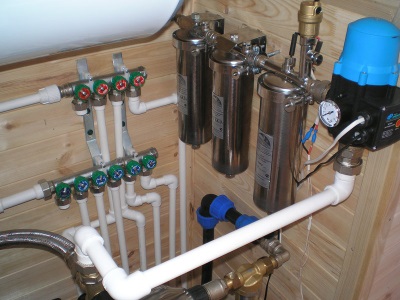
Development of the layout of facilities and pipeline
The layout of the connecting elements, cranes, water meters and pipe elements will be absolutely necessary for a qualitative result. It will help to calculate the number of connections and taps, to determine the location of the plumbing and to save time and materials.

Standard wiring diagrams include the following mandatory elements:
- Water meters;
- Shutoff and control valves;
- Filtering elements;
- Fittings (couplings, corners, seaweeds, adapters);
- Reducing valves;
- Check Valves;
- Approach from the riser to the heated towel rail;
- Sewer collector.
Deciding for yourself where will be located plumbing devices, you, on the basis of their dimensions, calculate the length and diameter of the feeding areas. After calculating the length of the sections and the number of additional parts, it remains to choose the appropriate kind of wiring.

Types of pipe routing
At the moment, in plumbing works the following 3 types are recommended:
- Collector (from parallel connection each object to the main pipes);
- Sequential (connection of each object to the main pipe through a separate tee);
- With plug-in sockets (similar to the serial, but instead of tees install sockets).
The last scheme of laying is used only in private houses. It will require the installation of an additional pump for supporting water and laying pipes of considerable length.
In the apartments, the first two schemes are used, they will be described in more detail.

Collector wiring
Among the existing proposals for the organization of water supply is the most reliable and practical. Each consumer is connected through its supply steam, with the help of cranes, the water supply to it can be adjusted at any time or completely cut off. Cranes are located on one small collector, which is hidden in a special cabinet. The supply pipes have a minimum of connections, and their laying can be carried out concealed.
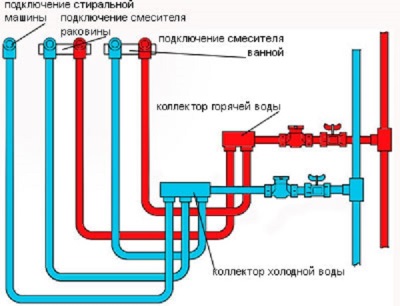
Of course, this option is quite expensive, because need stopcocks for each connection to the manifold. The work itself is laborious and will require accuracy of calculation and execution, so it will be more reasonable to entrust it to an experienced master. But the advantages are obvious: for service and repair of washing machines, mixers and other devices do not have to disconnect from the water supply all the bathroom at once.
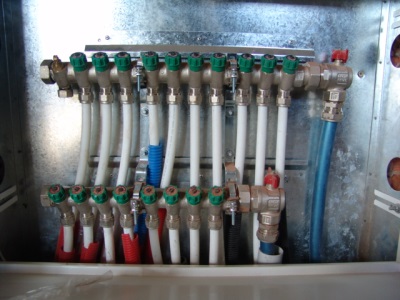
Sequential wiring
This type of pipe laying is applicable for rooms with a small number of consumers (a common mixer for a washbasin and a bathtub and access to a washing machine). A sequential scheme is convenient to implement if the bathroom is finished finishing work. Pipe laying using this scheme, as a rule, is open. In the tee scheme, the pipes have a small number of connections and are compact. The process of assembling itself is straightforward - you simply lay the main line from one consumer to another along the way bringing out the supply tubes from the tees. Such a procedure does not require the expenditure of a large amount of materials and additional expenditure.
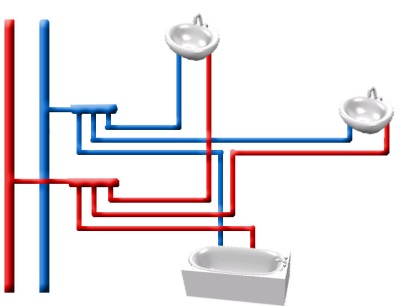
But when in your bathroom there are many points of water intake (separate faucets for a washbasin and a bath, a boiler, washer, a bathroom, a dishwasher) the work of this scheme becomes unsatisfactory. There may be a lack of water pressure for the simultaneous operation of all consumers.

In both cases considered there are a number of nuances that are always taken into account when assembling the water supply scheme:
- The number of connections must be minimal;
- The pipe and couplings must be made of homogeneous materials;
- Pipes should be heat-insulated so that condensation does not settle on them;
- You need free access to plug-in connections, filters and meters.
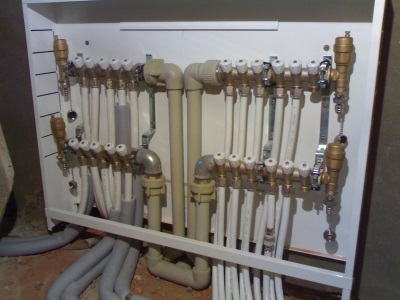
The right choice of pipes and their varieties
When considering piping for communications, note that the various materials are adapted for certain operating conditions and are seriously price different.
So, metal pipes made of galvanized steel or copper. The former are characterized by good heat transfer and strength. The latter are more durable and easily take the given shapes, but at the same time are the most expensive.
A cheaper alternative to steel and copper is plastic products. Plastic and metal-plastic pipes almost completely replaced the stainless steel pipes in the plumbing sector. Easy to handle and durable, they have made progress in quality and speed of installation.

Among their advantages, we note the following:
- pipes are easily connected by soldering, the joints themselves are resistant to pressure drops;
- plastic is not susceptible to corrosion, the internal surface is not silted and does not form a calcareous coating;
- products from polypropylene are cheaper than metal.
It is worth noting that pipes made of metal-plastic are less plastic, brittle and do not tolerate water hammers. Metal-plastic products are usually used in the sewage collection.

Hidden, open and combined method of laying pipes
The layout of communications in the bathroom can be arranged in 3 ways.
External wiring. Occurs when it is impossible to hide the pipes in the walls. This type of wiring allows you to constantly monitor the appearance of the connections and easily disassemble them in the event of clogging or replacement parts. Also, it is cheaper at attracting installers to the installation - from 7,000 rubles together with materials.
Concealed wiring. Due to the fact that all connections and areas are hidden under the lining, and only fittings for connections are outwardly exposed, this type of liner does not violate the interior design. Pipes are securely hidden in the walls can not be damaged by carelessness. But the process of doing laying works takes more time and effort. Before laying the walls, shtrobyat - cut channels for the placement of pipes. After laying the walls are closed, while maintaining the plane. Pipeline before installation should be clad in a casing according to construction norms.
As a result, the hidden method of laying is much more expensive than the distribution of pipes outside (from 12,000 rubles). Well, if we talk about bearing walls, then slugging them is prohibited in principle.

Hidden laying is possible only with unfinished finishing works. With the finished cladding, only an open and combined pipe assembly is possible.
Combined gasket is to lay pipes on the surface of unlined walls with subsequent installation of decorative false panels or boxes that hid the pipeline. This is a rather difficult method, since it will be necessary to harmoniously enter the projecting parts of the box into the interior and keep the cozy atmosphere in the room. Here, the profiling of the shape of the box by means of plasterboard and the external finishing with tiles and decorative elements come to the rescue.
Piping to the heated towel rail
The supply pipes can be stretched to the towel heater from the heating stand or from the hot water supply main. It is worth considering that when working from the CO, the radiator will function only in heating season. Also tapping of bends into the heating system will require for a while to shut off the flow on the riser, that representatives of housing and communal services do for a fee. In winter, such work is not carried out at all because of the risk of freezing the pipe.
Therefore, it will be more efficient to connect from a hot pipeline. At the same time, for convenience and saving of hot water between the main and the heated towel we recommend to put a bypass jumper. It connects the straight line and reverse pipe, and ball valves in front of the coil and after it allow you to cut off the towel rack in case it is replaced or to keep the heat.
When laying the supply pipes, you need to accurately withstand two dimensions: the interaxial distance of the nozzles for connecting the radiator and the minimum distance from the wall of the bathroom. For radiators with pipe diameters up to 23 mm, it is equal to 35 mm, for pipes with a diameter exceeding 25 mm - 50 mm. In general, 2-3 cranes for a bypass jumper, 2 tees for the main pipe and its terminals, 2 tees for the bypass and 2 couplings for connecting the coil are needed for connecting the heated towel rail.
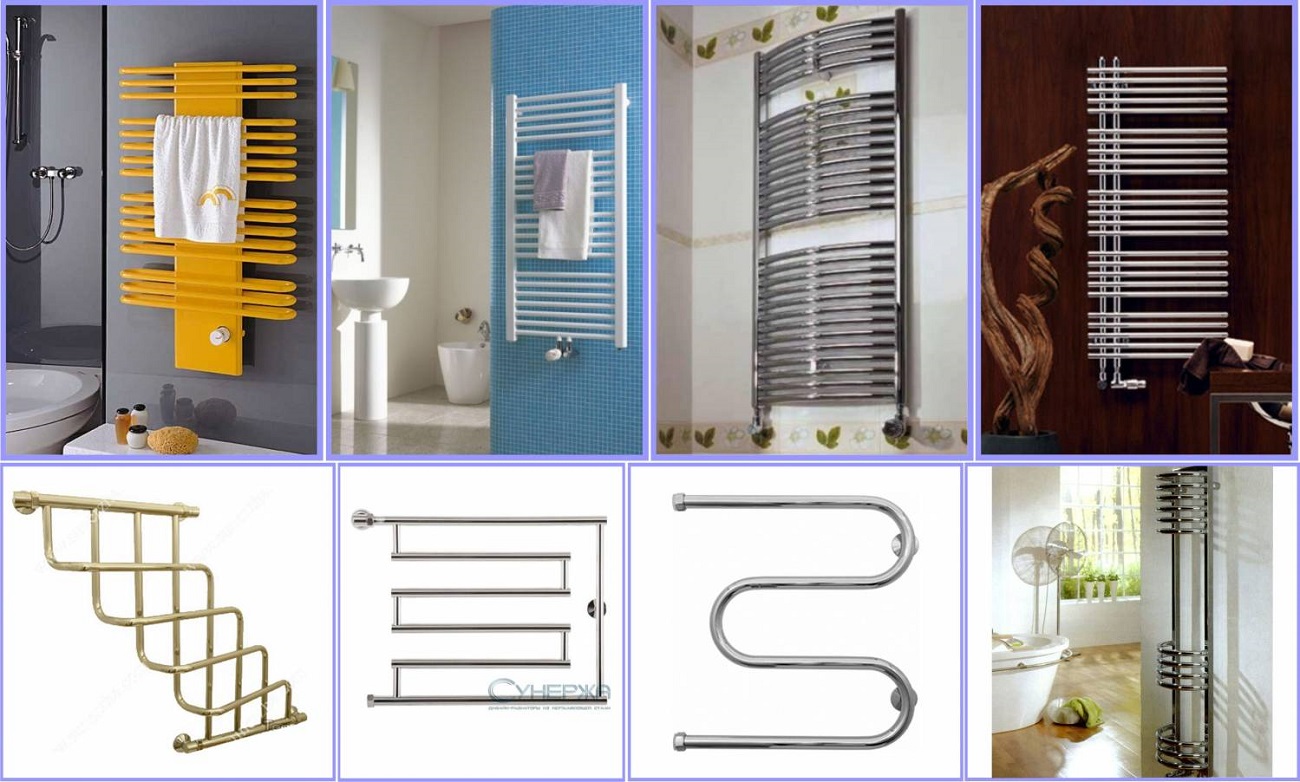


Piping of sewage pipes
Create wiring sewer pipes It is carried out taking into account a number of requirements for normal drainage and prevention of water stagnation. These requirements are as follows:
- The slope towards the drain collector is maintained. Its value is from 0.02 to 0.03 of the total length of the gasket.
- When assembling, it is not allowed to place the bends at right angles.
- In the areas before the turns, where possible blockages should be placed revision - tees with a removable cover. When the gasket is hidden, it is necessary to leave a viewing window opposite the revision.
- The diameter of the pipes should ensure a good cross-over for drains. The toilet bowls are connected to the collector pipes by not less than 100 mm in diameter, and the sinks and baths - by pipes with dimensions of 50-75 mm;
- When assembling, leave a margin for thermal expansion: the end of the pipe should not rest on the joint and not reach the bottom by 10 mm.
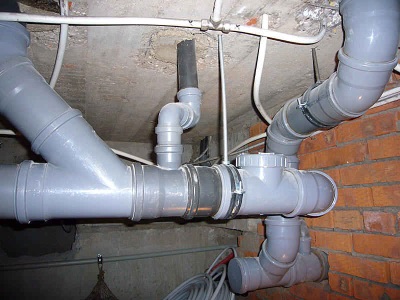
To obtain the required slope value, use the building level when marking the clamp mountings
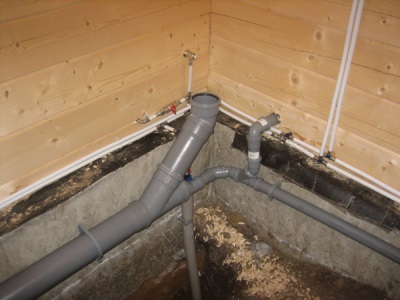
Laying and installation of pipes with own hands
With the finished pipe laying scheme and the selected laying method, you can start assembling the system. It should be noted that it is self-assembly of steel and copper pipes not succeed. Working with them requires skills in handling the welding machine and the accuracy of processing. Such a force is only an experienced professional. Therefore, in this section we describe the installation technique of polypropylene pipes. It is easy to learn and will require strict adherence to instructions.
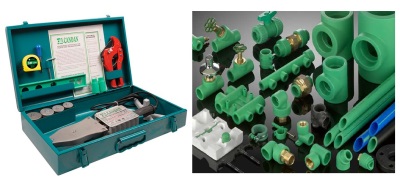
Prepare for work all the necessary materials and tools:
- Soldering iron for plastic pipes with nozzles of the desired diameter;
- Turbinka (Bulgarian);
- Pipe cutter or hacksaw for metal;
- Perforator;
- Sealing winding made of flax or pakli;
- Dowels with self-tapping screws;
- Polypropylene pipes;
- Adjustable wrenches;
- Ball Valves;
- Transitional couplings, bends, tees.
- Filters mechanical cleaning;
- Pressure reducer.

Dismantling of old pipes
You should start by dismantling previously installed communications. To do this, we shut off the water supply and distribute the detachable joints to drain the water. We unscrew all threaded joints and remove old cranes, couplings and tees. Elements, which are still in good condition and do not have any contamination inside, are completely fit for spare parts. Welded joints are cut by the Bulgarian. To get to the areas hidden in the walls use a puncher with a chisel.
If the fitting on the riser is threaded, a new control valve is attached to it, followed by a filter and a water meter. If the old pipe was fixed to welding, then we retreat from the seam of 10-15 centimeters, cut the pipe and cut the thread with a lance.

Pipes will be attached to connecting elements by soldering. For soldering, first install the cartridges and kegs of the correct size and turn on the palm. The optimum temperature for soldering 260 degrees, the corresponding mark is on the device's toggle switch.
We advise not to cut all sections of pipes in advance. It will be more correct to connect them consistently, so as not to miscalculate with the size. Cut pieces of pipes with a pipe cutter or a hacksaw. We clean the cut with a clerical knife from chips and burrs.

The time for the heating of the parts depends on the diameter and thickness of the pipe walls. You can independently find tables where it is normalized. In normal seconds, 5-7 is enough. The molten pipe or coupling without effort is rotated on the sleeve or pin and can be easily removed. After removing from the soldering iron two parts must be connected instantly. Press it all the way in, but without strong pressure. Within 3-5 seconds, you can rotate the parts, if suddenly set them crookedly. After the connected areas will finally grab and can not be separated any more. For practice, it does not hurt to practice on unnecessary trimming.
Pipes will be fastened along the walls due to plastic clamps. Those in turn are pressed against the walls with screws. Their design makes it easy to fix the pipe by snapping the lock and releasing it as easily.
After completing the installation, we will check the build quality. For a quarter of an hour, open the cold water supply. Then pass the same time through it hot water. Carefully check the condition of the threaded and soldered joints. In case of leaks, replace the unreliable connection immediately. In this case, it will be superfluous to stock up a couple more fittings.
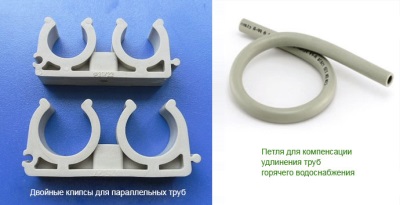
Some tweaks to simplify the work:
- In advance, mark and drill the holes for the dowels and secure the clamps. You do not need to tighten the yokes tightly until you try the pipe on them.
- To expose the tees and corners exactly, try them on the pipe before soldering and mark with a marker.
- Pipes can be brazed by weight and the harnesses already assembled must be fastened to the clamps. To collect everything, the previous prompt will help you.
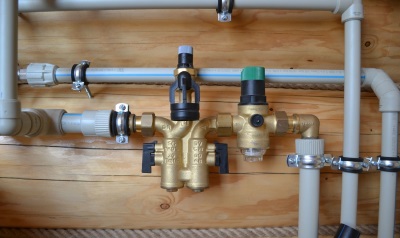
Safety during the laying of pipes
In order to protect yourself at work, prepare yourself a workplace - remove everything that prevents you from approaching the pipe installation sites. Before working in the bathroom, make sure that there are no open electrical outlets and bare wires nearby. After covering the water on the riser, open the duct to all valves to ensure that there are no gaps through the shut-off valve.
Working with the soldering iron will require caution to avoid burns and a fire. Do not leave the soldering iron unattended, always install it on a special stand when not in use. Choose for him a place on a fireproof surface away from flammable materials and liquids.
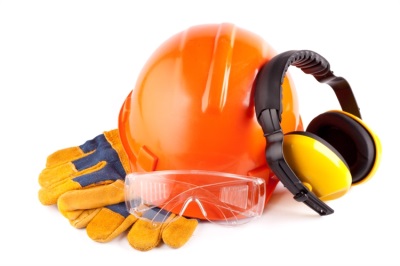
Take care of your own health and safety. Go to work in overalls from thick jeans with long sleeves and pants. Skirt on the feet of good work shoes. Cover your hands with gloves made of durable fabric. To protect the eyes before working with a puncher, wear protective goggles or a mask
Plumbing is one of the most important communications in the house, since the comfort of living depends on it. Therefore, it is very important to make it correctly, because water must necessarily be in the kitchen, bathroom and toilet. That is why many people are interested in the question of how to correctly make the water distribution in the apartment. Despite the fact that this task is not simple, because it requires the availability of certain knowledge and skills, nevertheless, everyone can cope with it. The main thing is to follow the instructions and observe the safety procedures.
Types of wiring: what to choose, reviews
Before finding out how the correct water distribution in the apartment is done, it is necessary to understand what types of water there are. Choosing the right wiring is very important, especially in small apartments, where each meter of free space is simply worth its weight in gold. There are two types of wiring - hidden and open. The first option is more suitable for small apartments, and the second one can be used in private houses. To understand which type is best for your housing, you need to understand all the advantages and disadvantages of each.
In addition, about each type of wiring there are both positive and negative reviews, having become acquainted with which, you can make the right choice for yourself.
Hidden layout: advantages and disadvantages
The hidden water distribution in the apartment is one of the most popular ways of laying communications and has certain advantages and disadvantages that should be considered when conducting a water pipe in a house or apartment.
Advantages
Among the main advantages of a hidden water pipeline are the following:
- more attractive appearance, as the pipes are not visible and do not spoil the aesthetics of the interior;
- the absence of pipes in the room allows you to move and arrange furniture without problems, as soon as your heart desires;
- in the event of a fire, the fire will not damage the pipes and the repair costs will be minimal.
All these advantages make it possible to realize any design project in a dwelling and make the interior more attractive.
disadvantages
 Despite the advantages listed above, the hidden layout of the water in the apartment has its drawbacks, which, unfortunately, are more:
Despite the advantages listed above, the hidden layout of the water in the apartment has its drawbacks, which, unfortunately, are more:
- limited choice of materials, because special types of wiring are required for this type of wiring;
- large time, financial and labor costs for stonewalling of walls and laying of pipes;
- installation of the pipeline requires complete removal of the finish and lining from the walls;
- the latent distribution of cold water in the apartment does not allow timely detection of pipe leaks;
- the lack of an opportunity to conduct an inspection of communications and the implementation of preventive measures;
- the probability of damage to pipes when drilling holes in the wall is high.
Thus, the list of shortcomings is quite impressive, so it is worthwhile to think carefully before conducting a hidden water pipe in the apartment.
Open wiring: the pros and cons
The alternative is hidden open wiring hot and cold water in the apartment. It requires less time and money, and is much easier to implement. Nevertheless, it has its pros and cons, which will be discussed later.
pros
![]() Among the main advantages of an open water pipeline are:
Among the main advantages of an open water pipeline are:
- for conducting communications you can use absolutely any pipes;
- a very simple installation process, since you do not need to bend the walls;
- perform dismantling or much easier than with closed wiring;
- in the case of pipes, you can immediately detect the problem and solve it;
- timely performance of preventive works.
Thus, this type of wiring has the greatest number of advantages, so most people choose it.
Minuses
The open water distribution in the apartment, in comparison with the closed one, has a much smaller number of disadvantages, among which one can distinguish:
- the pipes are in sight, so they spoil the aesthetic appearance of the dwelling;
- a significant decrease in the usable area in the room;
- in the case of using plastic pipes, the probability of damage to the water pipe in case of fire is high.
If the aesthetics for you is not in the first place and there is a free space in the house, then it is possible that these shortcomings will be irrelevant for you.
Designing the scheme of laying pipes
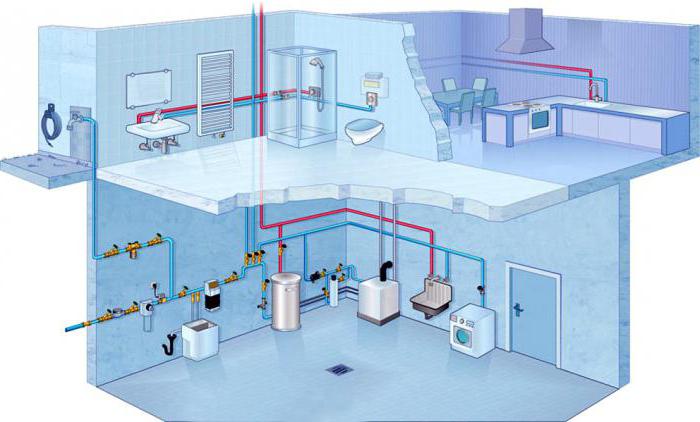 If you have defined the type of water supply, then the next stage requires a layout of the water distribution in the apartment. To create it should be approached very responsibly, because on how well the water supply system will be designed, comfort and comfort in housing depends. After all, you will agree, it will not be very pleasant if you take a shower and instead of running at a comfortable temperature, boiling water begins to run.
If you have defined the type of water supply, then the next stage requires a layout of the water distribution in the apartment. To create it should be approached very responsibly, because on how well the water supply system will be designed, comfort and comfort in housing depends. After all, you will agree, it will not be very pleasant if you take a shower and instead of running at a comfortable temperature, boiling water begins to run.
There are two main schemes - a sequential and a collector scheme, as well as a combined one, combining elements of both variants.
Sequential is a water circuit in which all points are connected in a certain sequence. A pipe runs from the common pipeline, feeding a large number of people at the same time. The main drawback of such a scheme is that when using water simultaneously by several consumers, the first will have the most high pressure and good pressure, but the latter will run much worse.
Collecting water distribution in the apartment is laid on a different principle. The supply of water from the main pipeline is made to the collector, and already from it is supplied to consumers by separate pipes. This scheme has a significant advantage, because each consumer has its own tap, which allows you to cut off the water supply for repair and maintenance work. In addition, the water pressure in each house or apartment will be the same. The main disadvantage of collector wiring is its high cost, since it requires more materials and elements.
Which pipes are better for running water?
![]() For today in building shops it is possible to meet set of types of pipes among which allocate:
For today in building shops it is possible to meet set of types of pipes among which allocate:
- Steel: they have high strength and durability, therefore they will last for several years. However, when choosing these pipes, it is necessary to take into account the fact that during operation the pipes will be gradually clogged, which significantly reduces the quality of water. In addition, with the installation steel pipes it is necessary to tinker considerably, since very precise threading is necessary for their laying.
- Pipes made of stainless steel: they are of the highest quality, since they do not oxidize during operation, however, due to their prohibitively high prices, not everyone can afford such pipes.
- Copper pipes: a universal option, because copper has excellent performance, high strength and excellent resistance to corrosion. In addition, the life of copper pipes is 70 years, but their cost is at an appropriate level.
- Metal-plastic pipes: the most common type of pipes, which has a low price, easy installation, excellent resistance to corrosion and the formation of various bacteria and harmful microorganisms in the pipes. However, they are not suitable for operation with very high temperatures exceeding 90 degrees.
- Polyethylene pipes: very common type, which has good strength, easy installation and cheapness. However, due to their poor resistance to high temperatures, they can only be used for cold water supply, so they are practically not used for communication wires in private houses and apartments.
- Pipes made of polypropylene: excellent for the implementation of hidden wiring in the apartment. They have high strength and are not subject to corrosion, and, therefore, have no effect on water quality. The service life is approximately 50 years.
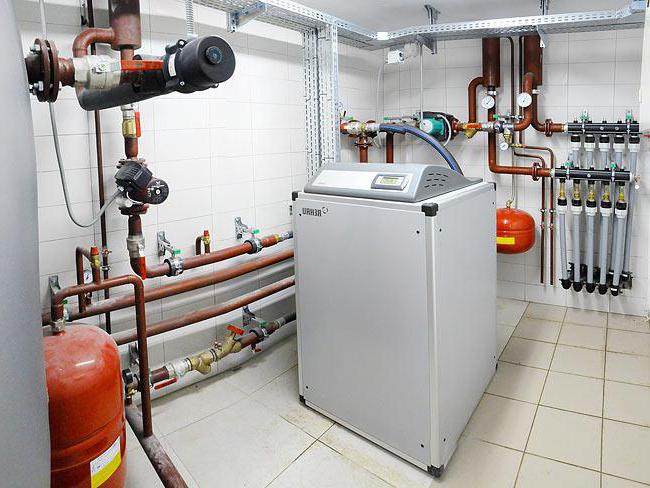 When choosing pipes for laying a water pipe, it is necessary to take into account the layout and type of wiring, as well as its financial capabilities. The best option will become metal-plastic pipes, because they are durable and are inexpensive.
When choosing pipes for laying a water pipe, it is necessary to take into account the layout and type of wiring, as well as its financial capabilities. The best option will become metal-plastic pipes, because they are durable and are inexpensive.
Piping the water pipe yourself
Once you have decided on all the nuances of the future water supply, you can begin to draw up a wiring diagram. The type of wiring, the diameter of the pipes, the exact length of the water pipe, the method of installation and the location of the bends must be taken into account. If you do not have such experience, it is better to seek professional help.
When the scheme is completed, you can proceed to purchase all the necessary materials. At the same time, 10 percent should be added to the calculated amount, because, as practice shows, you always have to buy.
If you plan to run a water pipe in an old building, in which there are already communications, the first thing to do is to dismantle the old pipes. To do this, it is required to shut off the water supply to the house or apartment. Then you can start laying pipes. It should be noted that we will answer the question of how to make water distribution in the apartment, using the example of laying plastic pipes. All works are performed in the following sequence:
- We cut pipes of the required length.
- Remove the protective bezel from the pipes.
- A pipe is put on the pipe and a ring is installed.
- The joints of the pipes are fixed by means of crimping fittings.
When all work is completed and the water distribution in the apartment is ready, the entire system is checked for leaks with a special device using a large air pressure. For prevention purposes, all fittings must be tightened every year, so that they do not spill and begin to flow.
 As it turned out, making the water distribution in the apartment with their own hands is not difficult. In the process of work you just need to follow the instructions, have the necessary materials, and also desire to make a reliable and durable wiring.
As it turned out, making the water distribution in the apartment with their own hands is not difficult. In the process of work you just need to follow the instructions, have the necessary materials, and also desire to make a reliable and durable wiring.



